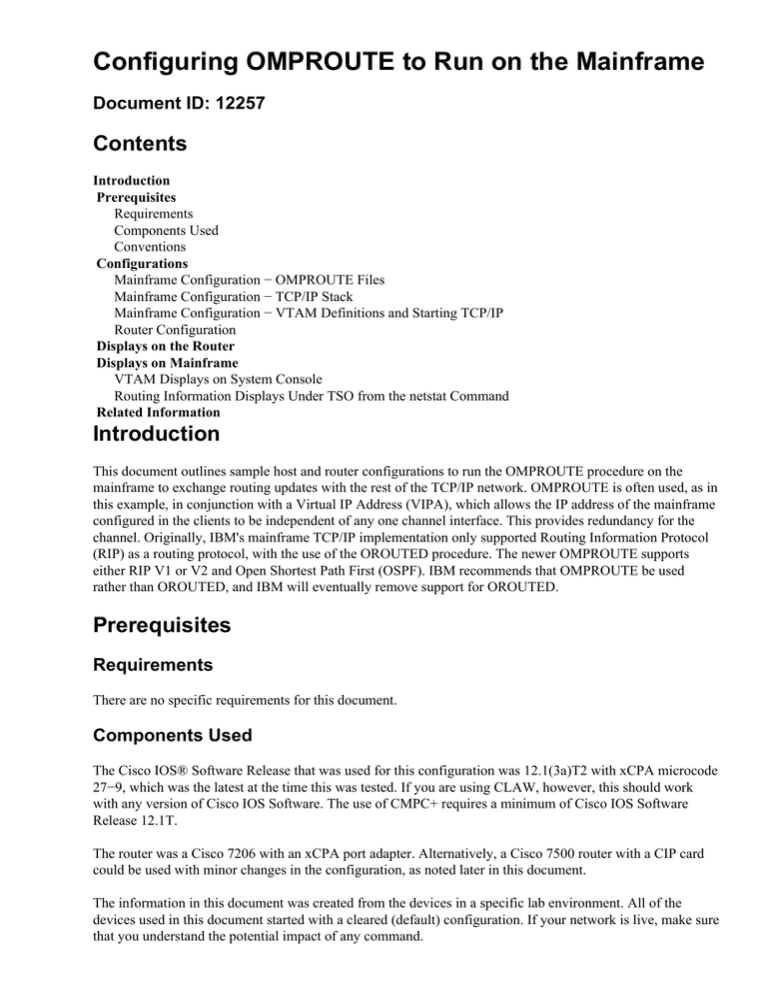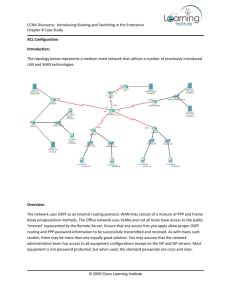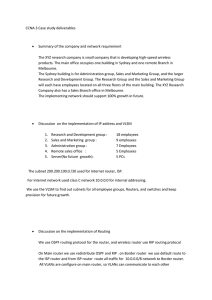
Configuring OMPROUTE to Run on the Mainframe
Document ID: 12257
Contents
Introduction
Prerequisites
Requirements
Components Used
Conventions
Configurations
Mainframe Configuration − OMPROUTE Files
Mainframe Configuration − TCP/IP Stack
Mainframe Configuration − VTAM Definitions and Starting TCP/IP
Router Configuration
Displays on the Router
Displays on Mainframe
VTAM Displays on System Console
Routing Information Displays Under TSO from the netstat Command
Related Information
Introduction
This document outlines sample host and router configurations to run the OMPROUTE procedure on the
mainframe to exchange routing updates with the rest of the TCP/IP network. OMPROUTE is often used, as in
this example, in conjunction with a Virtual IP Address (VIPA), which allows the IP address of the mainframe
configured in the clients to be independent of any one channel interface. This provides redundancy for the
channel. Originally, IBM's mainframe TCP/IP implementation only supported Routing Information Protocol
(RIP) as a routing protocol, with the use of the OROUTED procedure. The newer OMPROUTE supports
either RIP V1 or V2 and Open Shortest Path First (OSPF). IBM recommends that OMPROUTE be used
rather than OROUTED, and IBM will eventually remove support for OROUTED.
Prerequisites
Requirements
There are no specific requirements for this document.
Components Used
The Cisco IOS® Software Release that was used for this configuration was 12.1(3a)T2 with xCPA microcode
27−9, which was the latest at the time this was tested. If you are using CLAW, however, this should work
with any version of Cisco IOS Software. The use of CMPC+ requires a minimum of Cisco IOS Software
Release 12.1T.
The router was a Cisco 7206 with an xCPA port adapter. Alternatively, a Cisco 7500 router with a CIP card
could be used with minor changes in the configuration, as noted later in this document.
The information in this document was created from the devices in a specific lab environment. All of the
devices used in this document started with a cleared (default) configuration. If your network is live, make sure
that you understand the potential impact of any command.
Conventions
For more information on document conventions, refer to the Cisco Technical Tips Conventions.
Configurations
Mainframe Configuration − OMPROUTE Files
The configuration of OMPROUTE on the mainframe is very similar to the configuration of OROUTED.
OMPROUTE also uses a minimum of two configuration files. You must point to the location of these
configuration files, in the OMVS address space, with these two environment variables:
• export resolver_conf=/etc/resolv.conf
• export omproute_file=/etc/omproute.conf
This is an example of the contents of resolver_conf:
TCPJobName TCPIP
DomainOrigin cisco.com
domain cisco.com
Datasetprefix TCPIP
HostName P390
Messagecase mixed
The omproute_file will depend on whether RIP or OSPF is being used. This is an example configuration for
RIP:
;
Originate_RIP_Default Condition=Always Cost=1
;
RIP_Interface IP_Address=10.64.3.34
Name=LDIPTG
Subnet_Mask=255.255.255.240
Receive_Dynamic_Nets=YES
Receive_Dynamic_Subnets=YES
MTU=1470
Destination_Addr=10.64.3.33
;
RIP_Interface IP_Address=10.64.3.17
Name=VIPALINK
Subnet_Mask=255.255.255.240
MTU=1470
;
For OSPF, there are more configuration options available, which include the ability to make the mainframe
act as a stub area. This can significantly reduce the load routing updates that are placed on the channel when
many logical partitions (LPARs) are connecting over the same channel. This is an example:
Area Area_Number=0.0.0.0 Authentication_Type=None Stub_Area=NO
;
Comparison=Type2
;
AS_Boundary_Routing Import_Subnet_Routes=YES
Import_Direct_Routes=YES
;
OSPF_Interface IP_Address=10.64.3.34
Name=LDIPTG
Subnet_Mask=255.255.255.240
Attaches_To_Area=0.0.0.0
MTU=1470
Destination_Addr=10.64.3.33
Hello_Interval=30
Dead_Router_Interval=120
;
OSPF_Interface IP_Address=10.64.3.17
Name=VIPALINK
Subnet_Mask=255.255.255.240
Mainframe Configuration − TCP/IP Stack
The TCP/IP profile dataset does not require any special configuration for OMPROUTE, other than the fact
that you must comment out all of the static and default route configuration and the BSDROUTINGPARMS
section (which is only used by OROUTED). This extract shows only what must be commented out and the
parameters to which the OMPROUTE configuration files refer:
TCPIP Profile dataset
−−−−−−−−−−−−−−−−−−−−−
−−−−−−−−−−−−−−−−−−−−−−−−−−−−−−−−−−−−−−−−−−−−−−−−−−−−−−−−−−−−−−−−−−−−−−−
; Hardware definitions:
−−−−−−−−−−−−−−−−−−−−−−−−−−−−−−−−−−−−−−−−−−−−−−−−−−−−−−−−−−−−−−−−−−−−−−−
; NOTE: To use these device and link statements, update the statements
; to reflect your installation configuration and remove the semicolon
;
DEVICE DIPTG MPCPTP
LINK LDIPTG MPCPTP DIPTG
DEVICE VIPADEV VIRTUAL 0
LINK VIPALINK VIRTUAL 0 VIPADEV
;
;
; −−−−−−−−−−−−−−−−−−−−−−−−−−−−−−−−−−−−−−−−−−−−−−−−−−−−−−−−−−−−−−−−−−−−−−−
;
; HOME Internet (IP) addresses of each link in the host.
;
; NOTE: To use this home statement, update the ipaddress and linknames
; to reflect your installation configuration and remove the semicolon
;
HOME
10.64.3.17
VIPALINK
10.64.3.34
LDIPTG
; −−−−−−−−−−−−−−−−−−−−−−−−−−−−−−−−−−−−−−−−−−−−−−−−−−−−−−−−−−−−−−−−−−−−−−−
;
; IP routing information for the host. All static IP routes should
; be added here.
;
; NOTE: To use this GATEWAY statement, update the addresses and links
; to reflect your installation configuration and remove the semicolon
;
; GATEWAY
;
; Direct Routes − Routes that are directly connected to my interfaces.
;
; Network First Hop Link Name Packet Size Subnet Mask Subnet Value
; 10
=
CIS1
1500
0.255.255.0
0.101.1
; 10
=
LDIPTG
1500
0.255.255.240 0.64.3.32
; 9
=
LIS1
1500
0.255.255.0
0.117.56.0
; 130.50
=
TR1
2000
0.0.255.0
0.0.10.0
; 193.5.2
=
ETH1
1500
0
; 9
=
FDDI1
4000
0.255.255.0
0.67.43.0
; 193.7.2.2
=
SNA1
2000
HOST
;
; Indirect Routes − Routes that are reachable through routers on my
;
network.
;
;
;
;
;
;
;
;
;
;
;
;
;
;
;
;
;
;
;
;
;
;
;
;
;
;
;
;
Network
DEFAULTNET
193.12.2
10.5.6.4
First Hop
10.64.3.33
130.50.10.1
193.5.2.10
Link Name
LDIPTG
TR1
ETH1
Packet Size
DEFAULTSIZE
2000
1500
Subnet Mask
0
0
HOST
Subnet Value
Default Route − All packets to an unknown destination are routed
through this route.
Network
DEFAULTNET
First Hop
9.67.43.1
Link Name Packet Size
FDDI1
DEFAULTSIZE
Subnet Mask
0
Subnet Value
−−−−−−−−−−−−−−−−−−−−−−−−−−−−−−−−−−−−−−−−−−−−−−−−−−−−−−−−−−−−−−−−−−−−−−−
orouted Routing Information
if you are using orouted, comment out the GATEWAY statement and
update the BSDROUTINGPARMS statement to reflect your installation
configuration and remove the semicolon
Link
Maxmtu
Metric
BSDROUTINGPARMS false
LDIPTG
1500
0
VIPALINK
1500
0
TR1
2000
0
ETH1
1500
0
FDDI1 DEFAULTSIZE
0
ENDBSDROUTINGPARMS
Subnet Mask
Dest Addr
255.255.255.240
255.255.255.240
255.255.255.0
255.255.255.0
255.255.255.0
10.64.3.33
0
0
0
0
!−−− Note that all of the last two sections have been commented out.
Mainframe Configuration − VTAM Definitions and Starting TCP/IP
Routing updates can be exchanged over either CLAW or CMPC+ connections. If you are using CLAW, no
additional configuration is required on the mainframe. This example uses CMPC, which requires a VTAM
transport resource list (TRL) entry. This is the VTAM member:
DIPTGTRL VBUILD TYPE=TRL
*
*
DIPTG
TRLE LNCTL=MPC,MAXBFRU=16,READ=(E24),WRITE=(E25)
*
The TRL must be activated before the TCPIP started task is started. For example:
V NET,ACT,ID=DIPTRL1,UPDATE=ALL
IST097I VARY ACCEPTED
ISTTRL ACTIVE
Then, activate the TCP/IP started task with the S TCPIP MVS console command. Once the TCP/IP started
task is running, the OMPROUTE procedure can be started, either with the use of job control language (JCL)
as a started task or from within the OMVS address space. To start within OMVS, issue these commands:
cd /usr/lpp/tcpip/sbin
omproute &
To check that OMPROUTE is running, issue this console command, where p390 is the user ID under which
the OMPROUTE demon was started:
d omvs,u=p390
Router Configuration
Both CLAW and CMPC must be specifically configured to send broadcasts over the channel, with the
broadcast keyword. For example, for CLAW:
claw 0100 20 10.101.1.10 P390D C7000D TCPIP TCPIP broadcast
In this example, CMPC+ is in use, so these are the relevant parts of the router configuration:
!
interface Channel2/0
ip address 10.64.3.33 255.255.255.240
ip ospf network point−to−multipoint
no keepalive
cmpc 0100 24 DIPTG READ
cmpc 0100 25 DIPTG WRITE
tg DIPTG
ip 10.64.3.34 10.64.3.33 broadcast
router ospf 1
network 10.0.0.0 0.255.255.255 area 0
!
If this had been a Cisco 7500 router with a CIP card instead of a 7200 with an xCPA port adapter, the tg
statement would have been configured under the virtual /2 interface. Note the ip ospf network
point−to−multipoint command, which is required for OSPF to function correctly. The channel interface is
considered a multipoint interface much like Frame Relay. If you do not wish to run OSPF throughout your
network, you can run it only on the channel interface itself and use redistribution between other routing
protocols. For example:
!
router eigrp 1
redistribute ospf 1
passive−interface Channel2/0
network 10.0.0.0
no eigrp log−neighbor−changes
!
router ospf 1
log−adjacency−changes
redistribute eigrp 1
network 10.64.3.33 0.0.0.0 area 0
!
Displays on the Router
diplodocus# show extended channel 2/0 status
Path: 0100 −− ESTABLISHED
Command
Selective
System
Device
CU
Dev
Connects
Retries
Cancels
Reset
Reset
Errors
24
30
21
1
0
0
0
25
29
0
1
0
0
0
Blocks
Bytes
Dropped Blk
Memd
Dev−Lnk
Read
Write
Read
Write
Read
Write
wait
24−00
29
6
3484
789
0
0
0
25−00
9
29
801
3920
0
0
0
Path 0100
Total:
38
35
4285
4709
0
0
0
Last statistics 0 seconds old, next in 10 seconds
diplodocus# show extended channel 2/0 cmpc
Path
Dv
TGName
Dir
Bfrs
Status
Busy
0
0
Con
Y
Y
CMPC
CMPC
0100
0100
24
25
DIPTG
DIPTG
READ 16
WRITE 16
Active+
Active+
diplodocus# show ip ospf i
Channel2/0 is up, line protocol is up
Internet Address 10.64.3.33/28, Area 0
Process ID 1, Router ID 200.100.100.9, Network Type POINT_TO_MULTIPOINT,
Cost: 4
Transmit Delay is 1 sec, State POINT_TO_MULTIPOINT,
Timer intervals configured, Hello 30, Dead 120, Wait 120, Retransmit 5
Hello due in 00:00:10
Index 1/1, flood queue length 0
Next 0x0(0)/0x0(0)
Last flood scan length is 1, maximum is 1
Last flood scan time is 0 msec, maximum is 0 msec
Neighbor Count is 1, Adjacent neighbor count is 1
Adjacent with neighbor 10.64.3.17
Suppress hello for 0 neighbor(s)
diplodocus# show ip ospf neighbor
Neighbor ID
Pri
State
10.64.3.17
1
FULL/
Neighbor is up for 00:04:01
−
Dead Time
00:01:35
10.64.3.34
Address
Interface
Channel2/0
diplodocus# show ip route
Codes: C − connected, S − static, I − IGRP, R − RIP, M − mobile, B − BGP
D − EIGRP, EX − EIGRP external, O − OSPF, IA − OSPF inter area
N1 − OSPF NSSA external type 1, N2 − OSPF NSSA external type 2
E1 − OSPF external type 1, E2 − OSPF external type 2, E − EGP
i − IS−IS, L1 − IS−IS level−1, L2 − IS−IS level−2, ia − IS−IS inter area
* − candidate default, U − per−user static route, o − ODR
P − periodic downloaded static route
Gateway of last resort is 10.64.3.1 to network 0.0.0.0
1.0.0.0/27 is subnetted, 1 subnets
C
1.1.1.0 is directly connected, Loopback1
200.100.100.0/29 is subnetted, 1 subnets
C
200.100.100.8 is directly connected, Loopback0
10.0.0.0/8 is variably subnetted, 9 subnets, 3 masks
D
10.0.0.0/8 is a summary, 00:06:40, Null0
C
10.64.3.0/28 is directly connected, Ethernet6/0
O E2
10.64.3.17/32 [110/1] via 10.64.3.34, 00:03:57, Channel2/0
O
10.64.3.16/28 [110/5] via 10.64.3.34, 00:03:57, Channel2/0
C
10.64.3.32/28 is directly connected, Channel2/0
S
10.64.3.34/32 [1/0] via 10.64.3.34, Channel2/0
S
10.64.3.37/32 [1/0] via 10.64.3.37, Channel2/0
C
10.64.3.48/28 is directly connected, Serial1/3.1
C
10.64.3.128/28 is directly connected, Serial1/3.2
S*
0.0.0.0/0 [1/0] via 10.64.3.1
Displays on Mainframe
VTAM Displays on System Console
D NET,TRL
IST097I DISPLAY ACCEPTED
ST350I DISPLAY TYPE = TRL 042
IST1314I TRLE = DIPTG
STATUS = ACTIV
IST1454I 1 TRLE(S) DISPLAYED
IST314I END
CONTROL = MPC
D NET,TRL,TRLE=DIPTG
IST097I DISPLAY ACCEPTED
IST075I NAME = DIPTG, TYPE = TRLE 045
IST486I STATUS= ACTIV, DESIRED STATE= ACTIV
IST087I TYPE = LEASED
, CONTROL = MPC , HPDT = YES
IST1715I MPCLEVEL = HPDT
MPCUSAGE = SHARE
IST1577I HEADER SIZE = 4092 DATA SIZE = 60 STORAGE = ***NA***
IST1221I WRITE DEV = 0E25 STATUS = ACTIVE
STATE = ONLINE
IST1577I HEADER SIZE = 4092 DATA SIZE = 60 STORAGE = DATASPACE
IST1221I READ DEV = 0E24 STATUS = ACTIVE
STATE = ONLINE
IST314I END
Routing Information Displays Under TSO from the netstat Command
netstat route displays the routing table. For example:
===> netstat route
EZZ2350I
EZZ2755I
EZZ2756I
EZZ2757I
EZZ2757I
EZZ2757I
MVS TCP/IP NETSTAT CS V2R7
Destination
Gateway
−−−−−−−−−−−
−−−−−−−
10.0.0.0
10.64.3.33
10.64.3.32
0.0.0.0
10.64.3.33
0.0.0.0
TCPIP
Flags
−−−−−
UG
U
UH
NAME: TCPIP
15:56:33
Refcnt Interface
−−−−−− −−−−−−−−−
000000 LDIPTG
000000 LDIPTG
000000 LDIPTG
netstat device displays the status and so forth of all of the connected devices or links. For example:
===> netstat device
EZZ2350I
EZZ2760I
EZZ2761I
EZZ2762I
EZZ2768I
EZZ2769I
EZZ2770I
EZZ2810I
EZZ2811I
EZZ2760I
EZZ2761I
EZZ2762I
EZZ2768I
EZZ2769I
EZZ2770I
EZZ2810I
EZZ2811I
EZZ2812I
EZZ2813I
EZZ2814I
EZZ2814I
EZZ2760I
EZZ2761I
EZZ2762I
EZZ2768I
EZZ2769I
EZZ2770I
EZZ2810I
EZZ2811I
MVS TCP/IP NETSTAT CS V2R7
TCPIP NAME: TCPIP
15:58:04
DevName: LOOPBACK
DevType: LOOPBACK DevNum: 0000
LnkName: LOOPBACK
LnkType: LOOPBACK
Status: Ready
NetNum: 0
QueSize: 0
ByteIn: 0000004278
ByteOut: 0000004278
BSD Routing Parameters:
MTU Size: 00000
Metric: 00
DestAddr: 0.0.0.0
SubnetMask: 0.0.0.0
Multicast Specific:
Multicast Capability: No
DevName: DIPTG
DevType: MPC
DevNum: 0000
LnkName: LDIPTG
LnkType: MPC
Status: Ready
NetNum: 0
QueSize: 0
ByteIn: 0000001848
ByteOut: 0000001936
BSD Routing Parameters:
MTU Size: 01470
Metric: 01
DestAddr: 0.0.0.0
SubnetMask: 255.255.255.240
Multicast Specific:
Multicast Capability: Yes
Group
RefCnt
−−−−−
−−−−−−
224.0.0.5
0000000001
224.0.0.1
0000000001
DevName: VIPADEV
DevType: VIPA
DevNum: 0000
LnkName: VIPALINK
LnkType: VIPA
Status: Ready
NetNum: 0
QueSize: 0
ByteIn: 0000000000
ByteOut: 0000000000
BSD Routing Parameters:
MTU Size: 01470
Metric: 01
DestAddr: 0.0.0.0
SubnetMask: 255.255.255.240
Multicast Specific:
Multicast Capability: No
There are many more options available with netstat. You can issue the netstat ? command to display them
all.
Related Information
• IBM Technology Support
• Technical Support & Documentation − Cisco Systems
Contacts & Feedback | Help | Site Map
© 2014 − 2015 Cisco Systems, Inc. All rights reserved. Terms & Conditions | Privacy Statement | Cookie Policy | Trademarks of
Cisco Systems, Inc.
Updated: Sep 09, 2005
Document ID: 12257










